2009 Hyundai Santa Fe check engine
[x] Cancel search: check enginePage 157 of 269
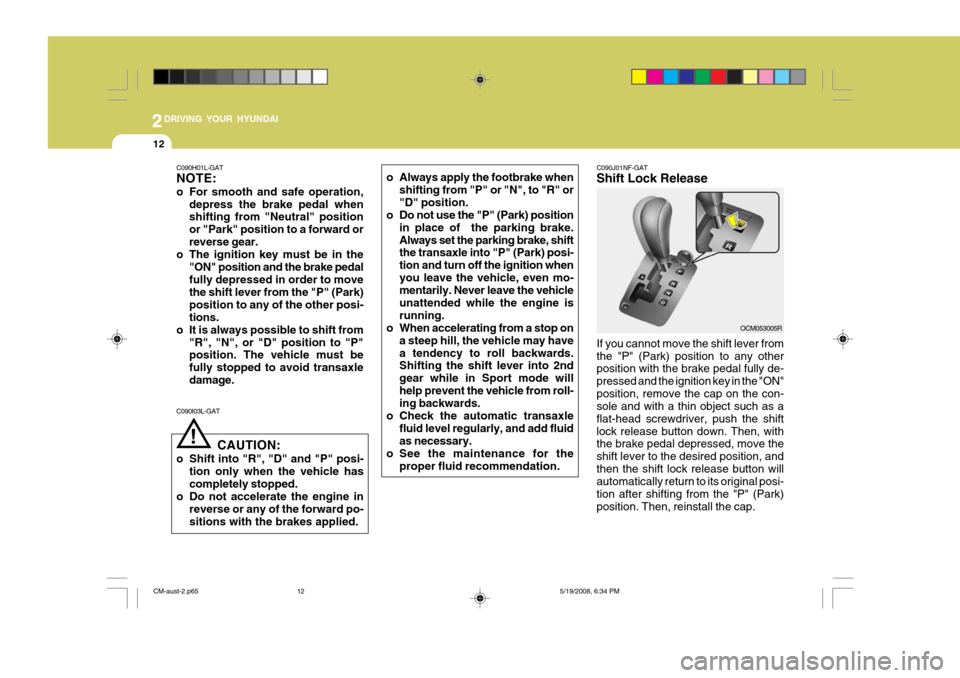
2DRIVING YOUR HYUNDAI
12
C090H01L-GAT NOTE:
o For smooth and safe operation,depress the brake pedal when shifting from "Neutral" position or "Park" position to a forward orreverse gear.
o The ignition key must be in the "ON" position and the brake pedalfully depressed in order to move the shift lever from the "P" (Park) position to any of the other posi-tions.
o It is always possible to shift from
"R", "N", or "D" position to "P" position. The vehicle must be fully stopped to avoid transaxledamage.
C090I03L-GAT
CAUTION:
o Shift into "R", "D" and "P" posi- tion only when the vehicle hascompletely stopped.
o Do not accelerate the engine in reverse or any of the forward po-sitions with the brakes applied.
! o Always apply the footbrake when
shifting from "P" or "N", to "R" or "D" position.
o Do not use the "P" (Park) position in place of the parking brake.Always set the parking brake, shift the transaxle into "P" (Park) posi- tion and turn off the ignition whenyou leave the vehicle, even mo- mentarily. Never leave the vehicle unattended while the engine isrunning.
o When accelerating from a stop on
a steep hill, the vehicle may havea tendency to roll backwards. Shifting the shift lever into 2nd gear while in Sport mode willhelp prevent the vehicle from roll- ing backwards.
o Check the automatic transaxle fluid level regularly, and add fluid as necessary.
o See the maintenance for the proper fluid recommendation.
C090J01NF-GAT Shift Lock Release If you cannot move the shift lever from the "P" (Park) position to any other position with the brake pedal fully de- pressed and the ignition key in the "ON"position, remove the cap on the con- sole and with a thin object such as a flat-head screwdriver, push the shiftlock release button down. Then, with the brake pedal depressed, move the shift lever to the desired position, andthen the shift lock release button will automatically return to its original posi- tion after shifting from the "P" (Park)position. Then, reinstall the cap. OCM053005R
CM-aust-2.p65
5/19/2008, 6:34 PM
12
Page 158 of 269
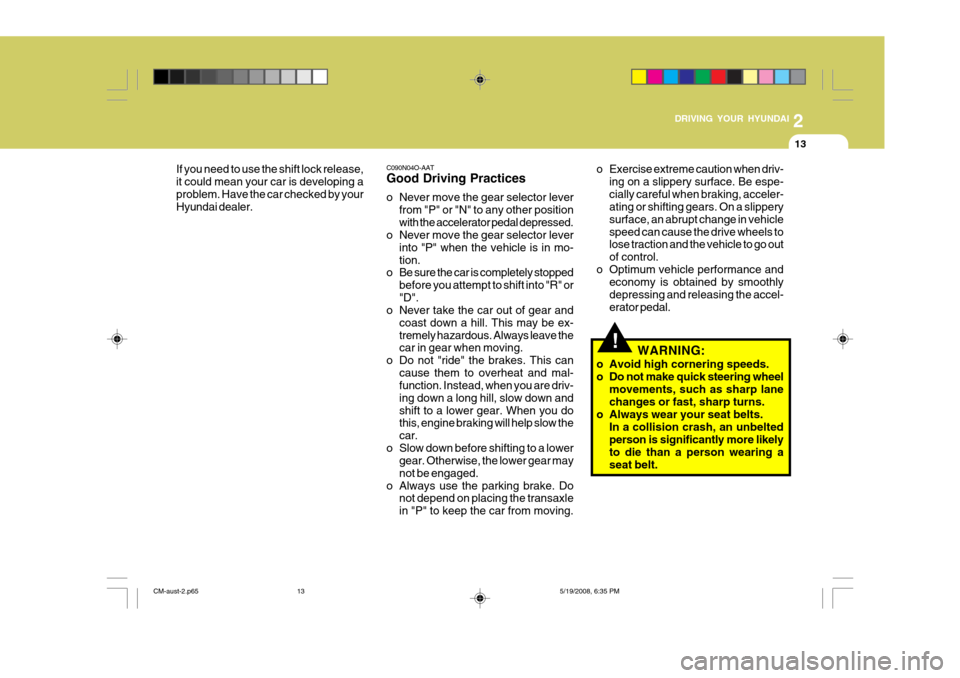
2
DRIVING YOUR HYUNDAI
13
!
C090N04O-AAT Good Driving Practices
o Never move the gear selector lever
from "P" or "N" to any other position with the accelerator pedal depressed.
o Never move the gear selector lever
into "P" when the vehicle is in mo-tion.
o Be sure the car is completely stopped
before you attempt to shift into "R" or"D".
o Never take the car out of gear and
coast down a hill. This may be ex-tremely hazardous. Always leave the car in gear when moving.
o Do not "ride" the brakes. This can cause them to overheat and mal-function. Instead, when you are driv- ing down a long hill, slow down andshift to a lower gear. When you do this, engine braking will help slow the car.
o Slow down before shifting to a lower gear. Otherwise, the lower gear maynot be engaged.
o Always use the parking brake. Do not depend on placing the transaxlein "P" to keep the car from moving.
If you need to use the shift lock release,it could mean your car is developing aproblem. Have the car checked by your Hyundai dealer.
o Exercise extreme caution when driv-
ing on a slippery surface. Be espe- cially careful when braking, acceler- ating or shifting gears. On a slippery surface, an abrupt change in vehiclespeed can cause the drive wheels to lose traction and the vehicle to go out of control.
o Optimum vehicle performance and economy is obtained by smoothlydepressing and releasing the accel-erator pedal.
WARNING:
o Avoid high cornering speeds.
o Do not make quick steering wheel movements, such as sharp lane changes or fast, sharp turns.
o Always wear your seat belts. In a collision crash, an unbelted person is significantly more likelyto die than a person wearing a seat belt.
CM-aust-2.p65 5/19/2008, 6:35 PM
13
Page 160 of 269
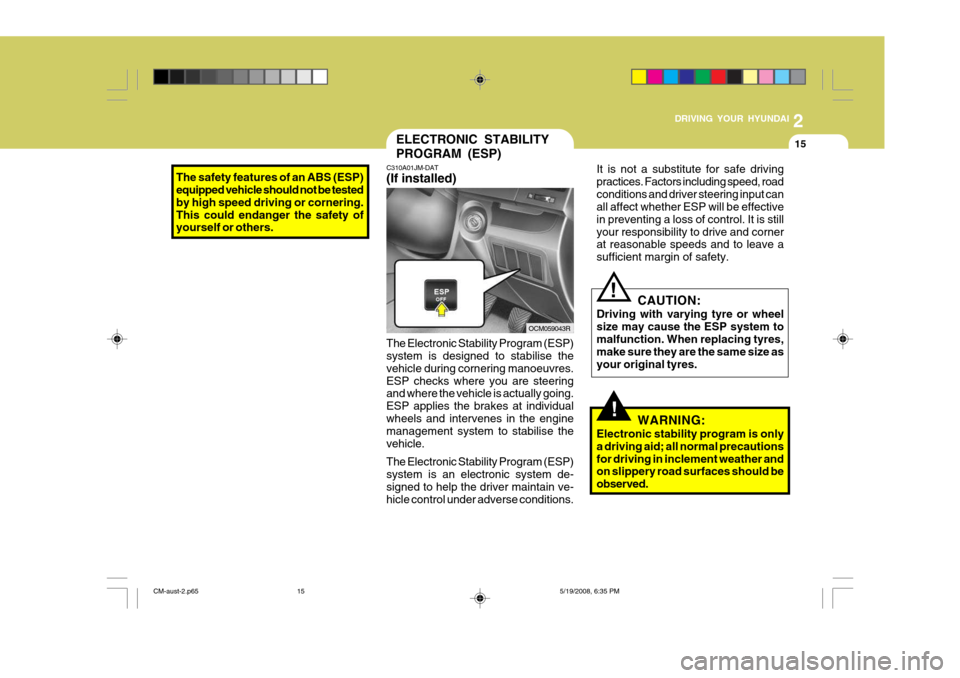
2
DRIVING YOUR HYUNDAI
15
The safety features of an ABS (ESP) equipped vehicle should not be tested by high speed driving or cornering.This could endanger the safety of yourself or others.
!
It is not a substitute for safe driving practices. Factors including speed, roadconditions and driver steering input can all affect whether ESP will be effective in preventing a loss of control. It is stillyour responsibility to drive and corner at reasonable speeds and to leave a sufficient margin of safety.
CAUTION:
Driving with varying tyre or wheelsize may cause the ESP system to malfunction. When replacing tyres, make sure they are the same size asyour original tyres.
WARNING:
Electronic stability program is onlya driving aid; all normal precautionsfor driving in inclement weather and on slippery road surfaces should be observed.
!
ELECTRONIC STABILITY PROGRAM (ESP)
C310A01JM-DAT (If installed) The Electronic Stability Program (ESP) system is designed to stabilise the vehicle during cornering manoeuvres.ESP checks where you are steering and where the vehicle is actually going. ESP applies the brakes at individualwheels and intervenes in the engine management system to stabilise the vehicle. The Electronic Stability Program (ESP) system is an electronic system de-signed to help the driver maintain ve- hicle control under adverse conditions. OCM059043R
CM-aust-2.p65
5/19/2008, 6:35 PM
15
Page 161 of 269
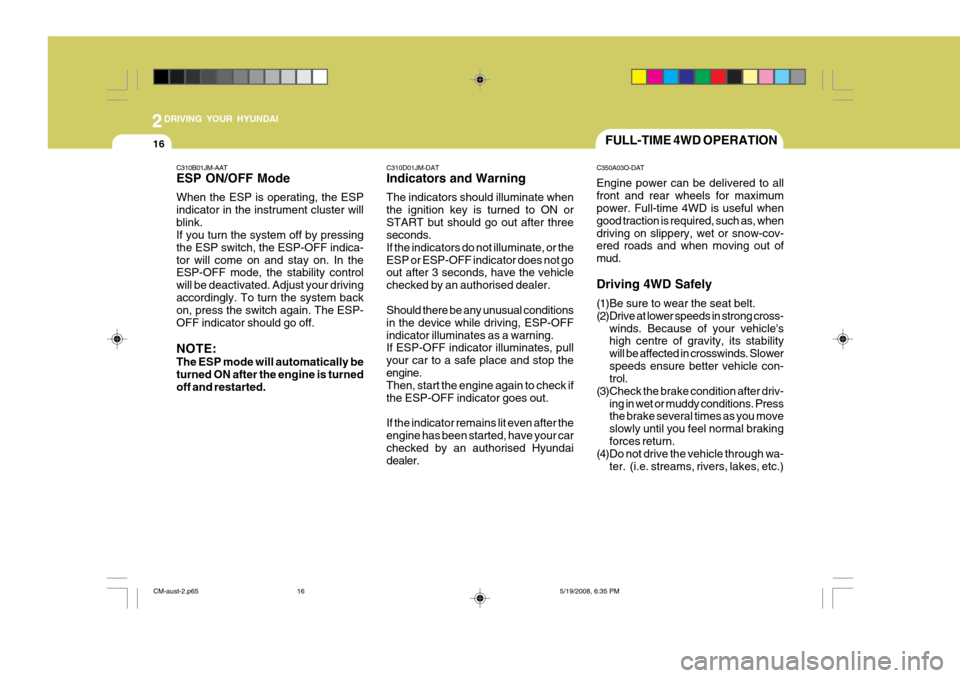
2DRIVING YOUR HYUNDAI
16FULL-TIME 4WD OPERATION
C350A03O-DAT Engine power can be delivered to all front and rear wheels for maximum power. Full-time 4WD is useful when good traction is required, such as, whendriving on slippery, wet or snow-cov- ered roads and when moving out of mud. Driving 4WD Safely
(1)Be sure to wear the seat belt.
(2)Drive at lower speeds in strong cross- winds. Because of your vehicle's high centre of gravity, its stability will be affected in crosswinds. Slowerspeeds ensure better vehicle con- trol.
(3)Check the brake condition after driv- ing in wet or muddy conditions. Pressthe brake several times as you move slowly until you feel normal brakingforces return.
(4)Do not drive the vehicle through wa-
ter. (i.e. streams, rivers, lakes, etc.)
C310B01JM-AAT ESP ON/OFF Mode When the ESP is operating, the ESP indicator in the instrument cluster willblink. If you turn the system off by pressing the ESP switch, the ESP-OFF indica-tor will come on and stay on. In the ESP-OFF mode, the stability control will be deactivated. Adjust your drivingaccordingly. To turn the system back on, press the switch again. The ESP- OFF indicator should go off. NOTE: The ESP mode will automatically be turned ON after the engine is turnedoff and restarted.
C310D01JM-DAT Indicators and Warning The indicators should illuminate when the ignition key is turned to ON orSTART but should go out after three seconds. If the indicators do not illuminate, or theESP or ESP-OFF indicator does not go out after 3 seconds, have the vehicle checked by an authorised dealer. Should there be any unusual conditions in the device while driving, ESP-OFFindicator illuminates as a warning. If ESP-OFF indicator illuminates, pull your car to a safe place and stop theengine. Then, start the engine again to check if the ESP-OFF indicator goes out. If the indicator remains lit even after the engine has been started, have your carchecked by an authorised Hyundai dealer.
CM-aust-2.p65
5/19/2008, 6:35 PM
16
Page 163 of 269

2DRIVING YOUR HYUNDAI
18
!
(9) When using tyre chains, be sure to
install the chains on all wheels.
(10) If the front or rear wheels get stuck
in the mud, do not spin them reck- lessly. The 4WD system could bedamaged.
CAUTION:
o While the full-time 4WD vehicle is being raised on a jack, never startthe engine or cause the tyres torotate.There is the danger that rotatingtyres touching the ground could cause the vehicle to go off the jack and to jump forward.
o If one of the front or rear wheels begins to spin in mud, snow,etc., the vehicle can sometimes be driven out by depressing the accelerator pedal further; how-ever, avoid running the engine continuously at high rpm because doing so could damage the 4WDsystem.
!
WARNING:
Keep away from the front of the ve- hicle while inspecting. This is very dangerous as the vehicle can jumpforward and cause serious injury or death. o In rare cases when it's unavoid-
able that a 4WD vehicle is to be inspected for speedometer test on 2WD roll tester, strictly follow the procedures next.
1. Check the tyre pressures rec-ommended for your vehicle.
2. Place the front wheels on the
roll tester for speedometer test as shown in the illustration.
3. Release the parking brake.
4. Place the rear wheels on the temporary free roller as shownin the illustration.
Roll tester(Speedometer)
(8)For speedometer test or inspection/ maintenance (I/M) program of SANTA FE 4WD, use a four wheel chassis dynamometer.
CAUTION:
Never engage the parking brake whileperforming these tests.
! OCM051013
Temporary free roller
CM-aust-2.p65
5/19/2008, 6:35 PM
18
Page 165 of 269

2DRIVING YOUR HYUNDAI
20
!
GOOD BRAKING PRACTICES
C130A01A-DAT o Don't coast down hills with the car
out of gear. This is extremely haz- ardous. Keep the car in gear at all times, use the brakes to slow down,then shift to a lower gear so thatengine braking will help you maintaina safe speed.
o Don't "ride" the brake pedal. Resting
your foot on the brake pedal whiledriving can be dangerous because itcan result in the brakes overheatingand losing their effectiveness. It alsoincreases the wear of the brake com-ponents.
o If a tyre goes flat while you are driving, apply the brakes gently andkeep the car pointed straight aheadwhile you slow down. When you aremoving slowly enough for it to besafe to do so, pull off the road and stop in a safe place.
o If your car is equipped with an auto-
matic transaxle, don't let your car creep forward. To avoid creepingforward, keep your foot on the brakepedal when the car is stopped.
o Use caution when parking on a hill. Engage the parking brake and placethe gear selector lever in "P" (auto-matic transaxle) or in first or re-
verse gear (manual transaxle).
WARNING:
Nothing should be carried on top ofthe shelf panel behind the rear seat. If there were an accident or a suddenstop, such objects could move for- ward and cause damage to the ve- hicle or injure the occupants.
o After being parked, check to be sure the parking brake is not engaged and that the parking brake indicator light is out before driving away.
o Driving through water may get the brakes wet. They can also get wet when the car is washed. Wet brakescan be dangerous! Your car will not stop as quickly if the brakes are wet. Wet brakes cause the car to pull toone side. To dry the brakes, apply the brakes lightly until the braking action returns to normal, taking careto keep the car under control at all times. If the braking action does not return to normal, stop as soon as it issafe to do so and call your Hyundai dealer for assistance.
1) Pressing the 4WD lock button on
the tough terrain, the driving power is equally distributed to the front and rear. 4WD lock keeps activating when not exceeding 40 km/h.
2) Release the 4WD lock button on the normal driving conditions.
1)
2)
OCM051047L
CM-aust-2.p65 5/19/2008, 6:35 PM
20
Page 168 of 269
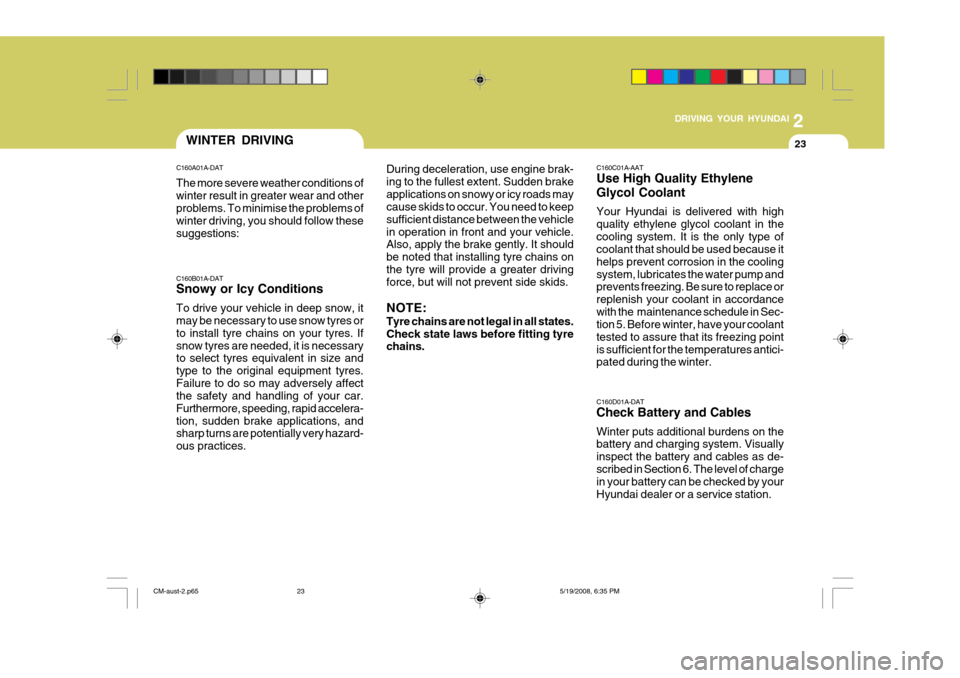
2
DRIVING YOUR HYUNDAI
23WINTER DRIVING
C160A01A-DAT The more severe weather conditions of winter result in greater wear and other problems. To minimise the problems of winter driving, you should follow thesesuggestions: C160C01A-AAT Use High Quality Ethylene Glycol Coolant Your Hyundai is delivered with high quality ethylene glycol coolant in thecooling system. It is the only type of coolant that should be used because it helps prevent corrosion in the coolingsystem, lubricates the water pump and prevents freezing. Be sure to replace or replenish your coolant in accordancewith the maintenance schedule in Sec- tion 5. Before winter, have your coolant tested to assure that its freezing pointis sufficient for the temperatures antici- pated during the winter.
C160B01A-DAT Snowy or Icy Conditions To drive your vehicle in deep snow, it may be necessary to use snow tyres or to install tyre chains on your tyres. If snow tyres are needed, it is necessary to select tyres equivalent in size and type to the original equipment tyres.Failure to do so may adversely affect the safety and handling of your car. Furthermore, speeding, rapid accelera-tion, sudden brake applications, and sharp turns are potentially very hazard- ous practices. During deceleration, use engine brak-ing to the fullest extent. Sudden brakeapplications on snowy or icy roads may cause skids to occur. You need to keep sufficient distance between the vehiclein operation in front and your vehicle. Also, apply the brake gently. It should be noted that installing tyre chains onthe tyre will provide a greater driving force, but will not prevent side skids. NOTE: Tyre chains are not legal in all states. Check state laws before fitting tyre chains.
C160D01A-DAT Check Battery and Cables Winter puts additional burdens on the battery and charging system. Visually inspect the battery and cables as de-scribed in Section 6. The level of charge in your battery can be checked by your Hyundai dealer or a service station.
CM-aust-2.p65 5/19/2008, 6:35 PM
23
Page 169 of 269

2DRIVING YOUR HYUNDAI
24
C160H01A-DAT Use Approved Anti-Freeze in Window Washer System To keep the water in the window washer system from freezing, add an approvedanti-freeze solution in accordance with instructions on the container. Window washer anti-freeze is available fromHyundai dealers and most auto parts outlets. Do not use engine coolant or other types of anti-freeze as these maydamage the paint finish.
C160G01A-DAT To Keep Locks from Freezing To keep the locks from freezing, squirt an approved de-icer fluid or glycerineinto the key opening. If a lock is cov- ered with ice, squirt it with an approved de-icing fluid to remove the ice. If thelock is frozen internally, you may be able to thaw it out by using a heated key. Handle the heated key with care toavoid injury. NOTE: The proper temperature for using the immobiliser key is from -40°C to 80°C. If you heat the immobiliser key over 80°C to open a frozen lock, itmay cause damage to the transpon- der in its head.
C160E01A-AAT Change to "Winter Weight" Oil if Necessary In some climates it is recommended that a lower viscosity "winter weight" oilbe used during cold weather. See Sec- tion 9 for recommendations. If you aren't sure what weight oil you should use,consult your Hyundai dealer. C160F01A-AAT Check Spark Plugs and Ignition System Inspect your spark plugs as described in Section 6 and replace them if neces- sary. Also check all ignition wiring and components to be sure they are notcracked, worn or damaged in any way.
CM-aust-2.p65
5/19/2008, 6:35 PM
24